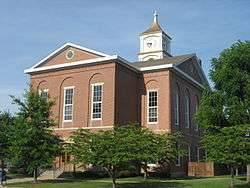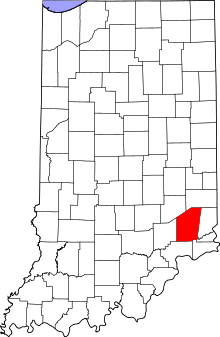Ripley County, Indiana
| Ripley County, Indiana | |
|---|---|
 Ripley County Courthouse in Versailles | |
 Location in the U.S. state of Indiana | |
 Indiana's location in the U.S. | |
| Founded | 1818 |
| Named for | Eleazer Wheelock Ripley |
| Seat | Versailles |
| Largest city | Batesville |
| Area | |
| • Total | 448.06 sq mi (1,160 km2) |
| • Land | 446.43 sq mi (1,156 km2) |
| • Water | 1.64 sq mi (4 km2), 0.37% |
| Population | |
| • (2010) | 28,818 |
| • Density | 65/sq mi (24.93/km²) |
| Congressional district | 6th |
| Time zone | Eastern: UTC-5/-4 |
| Website |
www |
| Footnotes: Indiana county number 69 | |
Ripley County (County Number 69) is a county located in the U.S. state of Indiana. As of 2010, the population was 28,818.[1] The county seat is Versailles.[2]
History
Ripley County was formed in 1816. It was named for Gen. Eleazer Wheelock Ripley, an officer in the War of 1812, who was mainly remembered for the Battle of Lundy's Lane and the Siege of Fort Erie, in 1814.[3]
Geography
According to the 2010 census, the county has a total area of 448.06 square miles (1,160.5 km2), of which 446.43 square miles (1,156.2 km2) (or 99.64%) is land and 1.64 square miles (4.2 km2) (or 0.37%) is water.[4]
Cities and towns
Unincorporated towns
- Benham
- Cross Plains
- Delaware
- Dewberry
- Friendship
- Morris
- New Marion
- Old Milan
- Pierceville
Townships
Adjacent counties
- Franklin County (north)
- Dearborn County (east)
- Ohio County (southeast [1])
- Switzerland County (southeast [2])
- Jefferson County (south)
- Jennings County (west)
- Decatur County (northwest)
Major highways
 Interstate 74
Interstate 74 U.S. Route 50
U.S. Route 50 U.S. Route 421
U.S. Route 421 State Road 46
State Road 46 State Road 48
State Road 48 State Road 62
State Road 62 State Road 101
State Road 101 State Road 129
State Road 129 State Road 229
State Road 229 State Road 350
State Road 350
National protected area
Climate and weather
| Versailles, Indiana | ||||||||||||||||||||||||||||||||||||||||||||||||||||||||||||
|---|---|---|---|---|---|---|---|---|---|---|---|---|---|---|---|---|---|---|---|---|---|---|---|---|---|---|---|---|---|---|---|---|---|---|---|---|---|---|---|---|---|---|---|---|---|---|---|---|---|---|---|---|---|---|---|---|---|---|---|---|
| Climate chart (explanation) | ||||||||||||||||||||||||||||||||||||||||||||||||||||||||||||
| ||||||||||||||||||||||||||||||||||||||||||||||||||||||||||||
| ||||||||||||||||||||||||||||||||||||||||||||||||||||||||||||
In recent years, average temperatures in Versailles have ranged from a low of 18 °F (−8 °C) in January to a high of 84 °F (29 °C) in July, although a record low of −28 °F (−33 °C) was recorded in January 1994 and a record high of 100 °F (38 °C) was recorded in July 1999. Average monthly precipitation ranged from 2.71 inches (69 mm) in February to 5.27 inches (134 mm) in May.[5]
Government
The county government is a constitutional body, and is granted specific powers by the Constitution of Indiana, and by the Indiana Code.
County Council: The county council is the legislative branch of the county government and controls all the spending and revenue collection in the county. Representatives are elected from county districts. The council members serve four-year terms. They are responsible for setting salaries, the annual budget, and special spending. The council also has limited authority to impose local taxes, in the form of an income and property tax that is subject to state level approval, excise taxes, and service taxes.[6][7]
Board of Commissioners: The executive body of the county is made of a board of commissioners. The commissioners are elected county-wide, in staggered terms, and each serves a four-year term. One of the commissioners, typically the most senior, serves as president. The commissioners are charged with executing the acts legislated by the council, collecting revenue, and managing the day-to-day functions of the county government.[6][7]
County Officials: The county has several other elected offices, including sheriff, coroner, auditor, treasurer, recorder, surveyor and circuit court clerk. Each of these elected officers serves a term of four years and oversees a different part of county government. Members elected to county government positions are required to declare party affiliations and to be residents of the county.[7]
Ripley County is part of Indiana's 6th congressional district and is represented in Congress by Republican Luke Messer.
Demographics
| Historical population | |||
|---|---|---|---|
| Census | Pop. | %± | |
| 1820 | 1,822 | — | |
| 1830 | 3,989 | 118.9% | |
| 1840 | 10,392 | 160.5% | |
| 1850 | 14,820 | 42.6% | |
| 1860 | 19,054 | 28.6% | |
| 1870 | 20,977 | 10.1% | |
| 1880 | 21,627 | 3.1% | |
| 1890 | 19,350 | −10.5% | |
| 1900 | 19,881 | 2.7% | |
| 1910 | 19,452 | −2.2% | |
| 1920 | 18,694 | −3.9% | |
| 1930 | 18,078 | −3.3% | |
| 1940 | 18,898 | 4.5% | |
| 1950 | 18,763 | −0.7% | |
| 1960 | 20,641 | 10.0% | |
| 1970 | 21,138 | 2.4% | |
| 1980 | 24,398 | 15.4% | |
| 1990 | 24,616 | 0.9% | |
| 2000 | 26,523 | 7.7% | |
| 2010 | 28,818 | 8.7% | |
| Est. 2015 | 28,701 | [8] | −0.4% |
| U.S. Decennial Census[9] 1790-1960[10] 1900-1990[11] 1990-2000[12] 2010-2013[1] | |||
As of the 2010 United States Census, there were 28,818 people, 10,789 households, and 7,910 families residing in the county.[13] The population density was 64.6 inhabitants per square mile (24.9/km2). There were 11,952 housing units at an average density of 26.8 per square mile (10.3/km2).[4] The racial makeup of the county was 97.6% white, 0.5% Asian, 0.2% American Indian, 0.2% black or African American, 0.5% from other races, and 0.9% from two or more races. Those of Hispanic or Latino origin made up 1.5% of the population.[13] In terms of ancestry, 43.4% were German, 14.2% were American, 13.9% were Irish, and 8.7% were English.[14]
Of the 10,789 households, 36.2% had children under the age of 18 living with them, 58.1% were married couples living together, 10.2% had a female householder with no husband present, 26.7% were non-families, and 22.8% of all households were made up of individuals. The average household size was 2.63 and the average family size was 3.08. The median age was 39.2 years.[13]
The median income for a household in the county was $47,697 and the median income for a family was $57,305. Males had a median income of $41,711 versus $31,927 for females. The per capita income for the county was $22,025. About 7.5% of families and 9.8% of the population were below the poverty line, including 14.3% of those under age 18 and 8.6% of those age 65 or over.[15]
See also
References
- 1 2 "Ripley County QuickFacts". United States Census Bureau. Retrieved 2011-09-25.
- ↑ "Find a County". National Association of Counties. Retrieved 2011-06-07.
- ↑ De Witt Clinton Goodrich & Charles Richard Tuttle (1875). An Illustrated History of the State of Indiana. Indiana: R. S. Peale & co. p. 572.
- 1 2 "Population, Housing Units, Area, and Density: 2010 - County". United States Census Bureau. Retrieved 2015-07-10.
- 1 2 "Monthly Averages for Versailles, Indiana". The Weather Channel. Retrieved 2011-01-27.
- 1 2 Indiana Code. "Title 36, Article 2, Section 3". IN.gov. Retrieved 2008-09-16.
- 1 2 3 Indiana Code. "Title 2, Article 10, Section 2" (PDF). IN.gov. Retrieved 2008-09-16.
- ↑ "County Totals Dataset: Population, Population Change and Estimated Components of Population Change: April 1, 2010 to July 1, 2015". Retrieved July 2, 2016.
- ↑ "U.S. Decennial Census". United States Census Bureau. Retrieved July 10, 2014.
- ↑ "Historical Census Browser". University of Virginia Library. Retrieved July 10, 2014.
- ↑ "Population of Counties by Decennial Census: 1900 to 1990". United States Census Bureau. Retrieved July 10, 2014.
- ↑ "Census 2000 PHC-T-4. Ranking Tables for Counties: 1990 and 2000" (PDF). United States Census Bureau. Retrieved July 10, 2014.
- 1 2 3 "DP-1 Profile of General Population and Housing Characteristics: 2010 Demographic Profile Data". United States Census Bureau. Retrieved 2015-07-10.
- ↑ "DP02 SELECTED SOCIAL CHARACTERISTICS IN THE UNITED STATES – 2006-2010 American Community Survey 5-Year Estimates". United States Census Bureau. Retrieved 2015-07-10.
- ↑ "DP03 SELECTED ECONOMIC CHARACTERISTICS – 2006-2010 American Community Survey 5-Year Estimates". United States Census Bureau. Retrieved 2015-07-10.
 |
Decatur County | Franklin County |  | |
| Jennings County | |
Dearborn County | ||
| ||||
| | ||||
| Jefferson County | Ohio County and Switzerland County |
Coordinates: 39°06′N 85°16′W / 39.10°N 85.26°W
